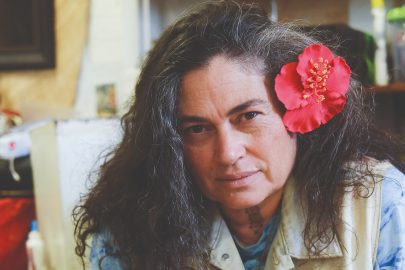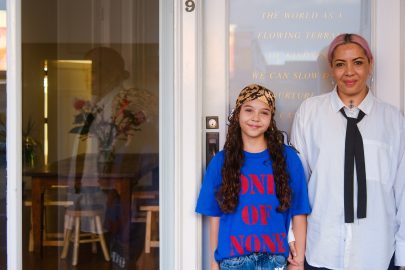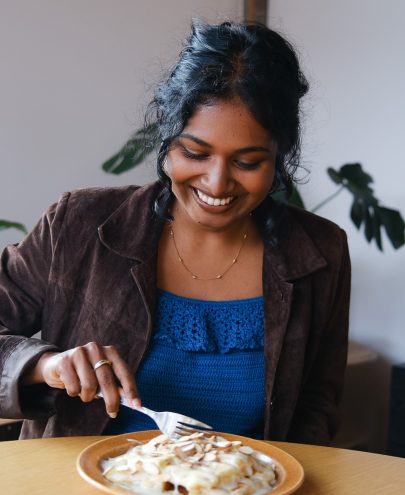May 25, 2018 Art
For almost 30 years, Michael Parekowhai has been one of New Zealand’s most influential artists. In a rare interview, he opens up about his work, the trauma of loss, and how he — with a little help from Marcel Duchamp — is transforming Te Papa.
On a stinking hot Saturday in late January, Michael Parekowhai makes coffee in the kitchen of his Henderson studio. He feeds three pods into the machine rapid fire, pop-pop-pop, puts the cup in front of me, then bangs a bowl of fridge-cold watermelon down on the table.
He’s dressed for the humidity: black singlet, grey sweatshorts and Allbirds sneakers the colour of a spearmint milkshake, his thick black hair held back by tortoiseshell sunglasses. He turns 50 this year, but has a shapeshifting ability to look, if not ageless, disconcertingly unplaceable.
“Making art is like smoking,” he says, as he joins me at the table. “It’s a bad hobby, it costs too much, and it’s bad for your health.”
Parekowhai loves a good one-liner. But despite being arguably New Zealand’s most visible contemporary artist (at least via his work), he is notoriously reluctant to give interviews. That’s partly about staying in control. It’s also about privacy: married with two kids, he’s deeply protective of his right to a personal life outside of art — especially since the media fallout connected to The Lighthouse on Queens Wharf.
He’s rarely photographed either; Google him and the most recent thing you’ll find is a portrait from 2011, when he was New Zealand’s representative at the Venice Biennale.
This invisibility, though, has also had its benefits, giving him a kind of mythic status within the culture. By letting his work do the talking, he’s left the rest of us to fight over its merits. He is also a trickster; an artist who revels in ambiguities, and loves the moment when one thing — whether it’s a statement or a work of art — turns out to actually be something else.
Jenny Harper, the outgoing director of the Christchurch Art Gallery, calls Parekowhai a magician. “Whatever he creates,” she says, “he maintains an edge of drama and surprise. He engages with and jests about aspects of Maori and Pakeha culture, high and low. He has an individuality and self-assured sense of New Zealand identity, partnered with Duchampian wit and savvy.”
“Duchampian” is an adjective you hear a lot in relation to Parekowhai: a reference to the French artist Marcel Duchamp — another trickster — who transformed the history of Western art by inventing the “readymade”, taking manufactured objects such as bicycle wheels and urinals, putting them in galleries, and calling them art.
Parekowhai likes Duchamp, a lot: a decades-long love affair that began when he was a student. “At art school, Duchamp was the portal that allowed us to start understanding contemporary art,” he says.
Art school was also when Parekowhai got his first break, with works that paid homage to the French master and catapulted him into the foreground of New Zealand’s postcolonial debates. Now, almost 30 years later, he’s about to unleash his fascination with Duchamp yet again, this time in Te Papa, in one of the most ambitious projects of his career.
The idea behind Te Papa — that New Zealand needed to throw off the colonial shackles and express its national culture in an independent, contemporary way — emerged at exactly the same time as Parekowhai and his peers like Shane Cotton and Peter Robinson. “We were trying to smash doors down,” he says of the way they began to take on Pakeha-dominated institutions and galleries.
By the time Te Papa finally opened in 1998, Parekowhai’s generation of Maori artists were already exposing the cracks in the idea of “Our Place”. In March, as Te Papa lets him loose in its newly renovated art galleries, he may finally blow the national museum’s doors all the way off.
In 1990, when Leonard was a young curator at the National Art Gallery in Wellington, he saw an exhibition at Auckland’s Artspace of contemporary Maori art, curated by George Hubbard. It was called Choice! There was Jacqueline Fraser, Diane Prince, Lisa Reihana, and a handful of others. Among them was a 22-year-old called Michael Parekowhai.
“Michael’s Choice! sculptures would really shape my thinking,” Leonard says. “They did something new and surprising. They eschewed familiar Maori-art styles and references, yet asserted a Maori world view.”
The best known of those works is The Indefinite Article (1990), Parekowhai’s giant wooden letters that spell out “I AM HE”: a bold claim to greatness from a newbie, a reference to Colin McCahon’s “I AM” paintings, and a play on the letters that make up his own first name, minus the ones — “c” and “l” — that aren’t in the Maori alphabet.
A year earlier, Parekowhai had made After Dunlop, a replica of Duchamp’s infamous Bicycle Wheel, which was mounted on a stool as though it were a masterpiece on a pedestal. As Leonard wrote back in 1994: “Being an art student means immersing yourself in the great art of the past, all the while struggling to find a voice of your own. That’s a tall order. Parekowhai’s response to this challenge was to cut Duchamp down to size by building him up. Parekowhai lovingly fashioned a replica of the Bicycle Wheel in wood, rewriting it as a Maori carving. Honouring Duchamp’s critique of craft in a crafty replica, Parekowhai trumped the Frenchman.”
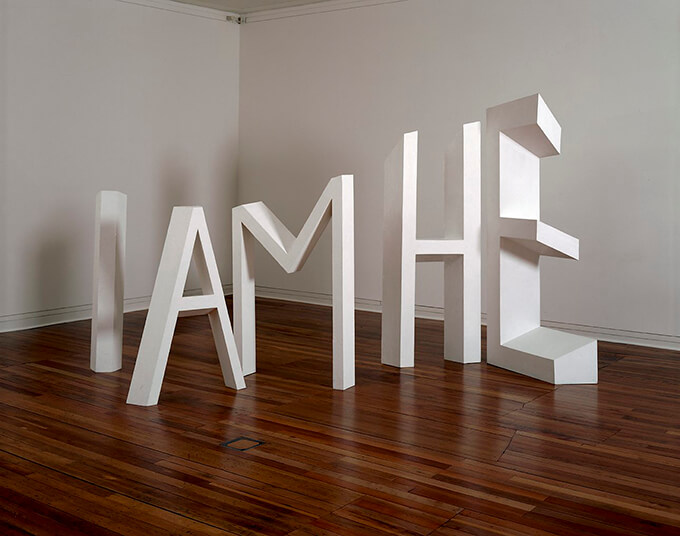
Clever, arch, and oh-so-postmodern, it’s not surprising it lit up Leonard and other young curators emerging at that time: a small group of museum professionals desperate to break the shackles of (Pakeha-invented) nationalism in the country’s public galleries.
And yet there was still something definitively local — and decidedly barbed — underpinning Parekowhai’s works. “They seemed to emphasise cultural difference because they spoke through appropriated forms and references,” Leonard says. “His work opened up a new set of possibilities. It felt like a break with the older generation of Maori artists; it was game-changing.”
Megan Tamati-Quennell, Te Papa’s curator of modern and contemporary Maori and indigenous art, agrees.
“Michael’s work expanded the definition of contemporary Maori art. Choice! wanted to showcase art from Maori artists who were more than ‘bearers of tradition or children of nature, representers of the land and the past’,” she says, quoting George Hubbard and Robin Craw’s catalogue essay from the exhibition. “And I think it showed Michael’s significance.”
Two years after Choice!, Leonard included Parekowhai as the youngest artist in Headlands: Thinking through New Zealand Art, a seminal exhibition at Sydney’s Museum of Contemporary Art. It was a pretty astounding rise for a kid who, a few years earlier, had dropped out of Northcote College to go to floristry school, a move that was disastrous. He failed with the flowers, went back to high school, and ended up at Elam School of Fine Arts instead.
Years later, though, in 2001, he made The Consolation of Philosophy — photographs of flower arrangements named after famous battles in which the Maori Battalion fought. “It’s not about the fallen soldiers,” he says of the series. “It’s more about the land. It’s turangawaewae. Whether I’m in Paris, or Venice, or West Auckland, my position is my position.”
Headlands placed Parekowhai and his peers at the heart of what would become a generation-defining debate. In the accompanying catalogue, young art historian Rangihiroa Panoho wrote an essay that criticised painter Gordon Walters’ appropriation of traditional kowhaiwhai. For some, like the late Francis Pound, this was an attack too far. Academic acrimony ensued. New Zealand art history got angry, and the country’s art entered a new postcolonial moment.
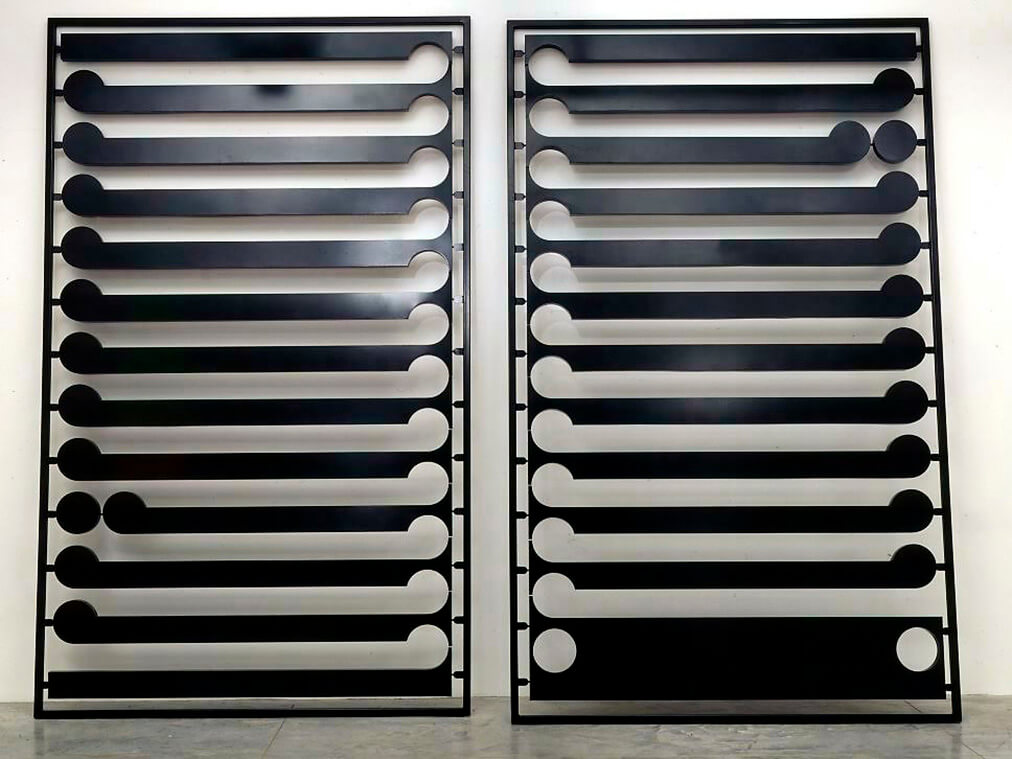
Parekowhai and his contemporaries were first caught in the headlights, then elevated into the spotlight: Cotton had his paintings that appropriated symbols and images from New Zealand’s colonial past. Robinson had his “Percentage Paintings”, which explored precisely how much Maori blood he had, and, a little later and even more infamously, his “Pakeha Have Rights Too!” swastika paintings.
“I never had sellout shows like Shane and Peter,” Parekowhai jokes, when I ask him what that period was like. “It was a slow thing. [The late art dealer] Greg Flint said to me once, ‘You don’t want to be a skyrocket, boy’.”
Parekowhai’s wry sculptures, though, have become icons of the time, including Kiss the Baby Goodbye (1994), a giant version of a Walters koru painting as a kitset. It’s modelled on Walters’ painting Kahukura, made in 1968 — the year Parekowhai was born. One translation for its title is “rainbow”. Parekowhai whakapapas to Nga Ariki Rotoawe on the East Coast near Gisborne, an iwi almost wiped out in the 19th century, whose mythology is rich with references to rainbows and the stars.
Since making Kiss the Baby Goodbye, the rainbows have never left him. His now-ubiquitous bowler-hatted men are collectively titled Over the Rainbow. And The Lighthouse, of course, is filled with star constellations in the colours of the rainbow spectrum. “My dad calls it the rainbow house,” he tells me, smiling.
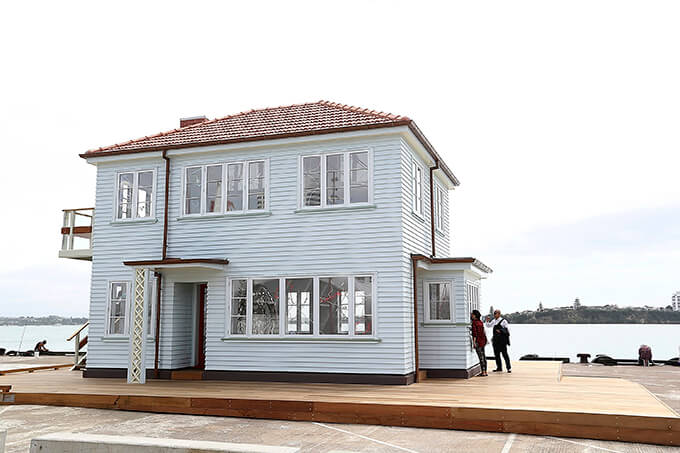
Parekowhai’s parents were both teachers. “We learned from an early age that knowledge is everything,” he says.
The Parekowhais’ role as educators, of Maori children in particular, was documented around 1963 by Ans Westra (who not long after would publish her most debated photo-essay of Maori life as she saw it, Washday at the Pa). At the time, the Parekowhais were teaching in Parikino, on the Whanganui River.
“Dad found her sleeping on the side of the road in her car,” Parekowhai says, “and told her it wasn’t safe there for a woman on her own, so he brought her home.” Westra ended up taking photographs in the Parekowhais’ classrooms, including one of her best known, of a barefoot Maori boy called Matene standing on tip-toes and writing the time on the blackboard. In others, the Parekowhais themselves are shown teaching children.
Michael was born five years later in Porirua. By the time he was six, the family had settled in Northcote. Soon after, one of his older brothers, Thomas, was killed by a car at a pedestrian crossing. It was the defining event of his early life, and has been a subject he’s periodically returned to in his sculpture ever since. “A lot of my work is about voids,” he says. “And you can never fill that void of a lost sibling.”
In his 2011 Venice Biennale exhibition, he included a pair of child’s Crocs cast in bronze, in memory of his late brother and as a tribute to his own son. Other family members have been represented in his work too. His well-known “security guard” sculptures, collectively known by the title Kapa Haka, are modelled on another of his older brothers, Paratene.
In his series Poorman, Beggarman, Thief, three identical mannequins stand in tuxedos, wearing labels that read “My Name is Hori”. Hori, as well as being a hideous racial epithet, is the translation of his father’s name, George (the mannequins’ features are, Parekowhai explains, halfway between his own and his dad’s). His older sister Cushla has also been a key figure for him throughout his career. When I ask him exactly what form that’s taken, he shrugs. “She’s my big sister,” he says. Evidently, one never quite escapes being the baby in the family.
A “pare” is the bun or top-knot often worn by Maori warriors. The kowhai is a bright yellow flower. Parekowhai, the failed florist, likes the idea that his ancestors went into battle with flowers in their hair.
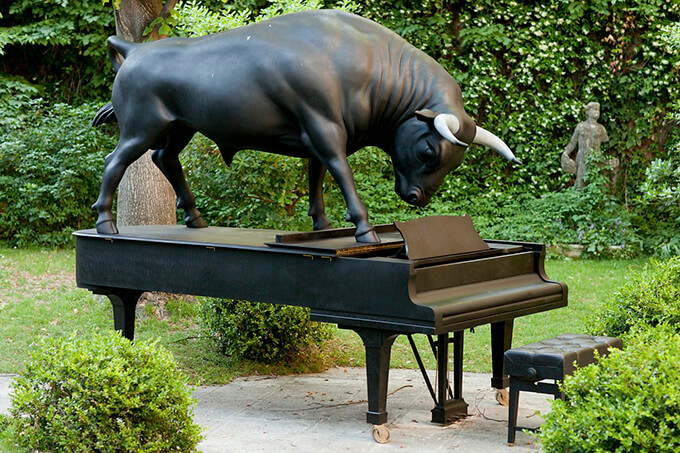
He looms large, and for some, the shadow has become just a little too long. He’s been accused of being a bit too easy on the Pakeha eye, and of making art geared for his vociferous market (open a contemporary art auction catalogue or a posh Auckland property magazine and there’s a good chance there’ll be a sprinkling of Parekowhai works on show). Rangihiroa Panoho — the same art historian who kicked off the appropriation debate in 1992 — somewhat dismissively suggested in his 2015 book Maori Art: History, Architecture, Landscape and Theory that Parekowhai’s work was popular with curators like Leonard and Greg Burke in the 90s because it was internationally on-trend and built on his “fashionably-ambivalent identity”.
In 2013, Christchurch Art Gallery launched a public fundraising campaign to help buy Chapman’s Homer, one of Parekowhai’s bulls atop a piano from his Venice exhibition. Jenny Harper, the director, had also been the commissioner for Parekowhai’s Venice outing, and arranged the exhibition of his project in the city, including two bronze bull-and-piano sculptures and a playable Steinway, carved and painted a vivid red. Harper says the exhibition became an emblem for Christchurch’s trauma and recovery. “[It] became the first reason many people came back into the centre of our city,” she says. “As for the [carved] piano upstairs, people stayed and listened and cried as they looked out onto the red zone and the damage wrought … I’ve believed in the power of art for a long time now, but who could have predicted how potent a presentation this would become when it was here? It was extraordinary and moving.”
Other projects haven’t been greeted so warmly. In 2011, Parekowhai won a million-dollar commission from the Queensland Government for a major new sculpture outside Brisbane’s Gallery of Modern Art. Prominent Aboriginal artist Fiona Foley criticised both the decision to give Parekowhai the commission and his appropriation of the kuril water rat, an important symbol of the local Aboriginal people. The Queensland Minister for the Arts got in on the act, too, openly stating that, if they could have got out of the contract, they would have in a heartbeat.
That number — a million dollars — was the same figure that caused the proverbial to hit the fan when, in 2014, after a gift to Auckland from Barfoot & Thompson, Parekowhai’s plans for The Lighthouse on Queens Wharf — with an exterior in the form of a 1950s state house — were leaked. He refuses to be drawn on the controversy, just as he refused to give any interviews when it was unfolding. It’s clear that the experience hurt him, though, especially when the work and the issues it was trying to address were misrepresented by certain corners of the media. There were even rumours of pressure from some at the council to return Barfoot & Thompson’s gift — which would have been an incredible affront both to the company and to one of New Zealand’s senior artists.
Even when the final work was revealed in February 2017, new mayor Phil Goff hedged his bets, acknowledging in a Radio New Zealand interview Barfoot & Thompson’s generosity while making no mention of Parekowhai before garbling that “art, like beauty, is in the eye of the beholder… it’s an interesting building. I think I’ll leave my comments at that.” Goff said he couldn’t attend either opening event because of other commitments. He also pointedly said the decision to build it on Queens Wharf had been made before he became mayor.
As projects become bigger the stakes get higher, particularly in a small society like New Zealand’s, and particularly in an environment where every cent spent on the arts is so brutally scrutinised. It’s left plenty of artists gun-shy. Parekowhai’s silence on The Lighthouse, though, shouldn’t be mistaken for a lack of fight — as his Te Papa project is about to show.
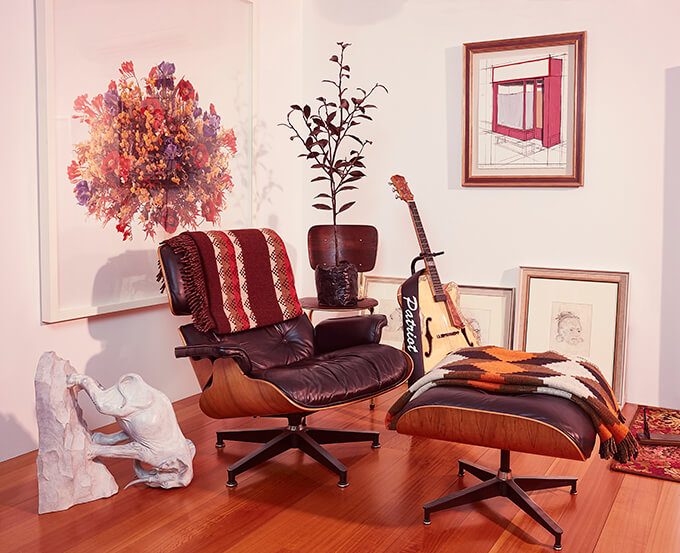
For Tamati-Quennell, Parekowhai was the obvious artist to have first shot at the first space, the “threshold” to the main galleries. “I thought Michael would be able to create a project that was accessible to the everyday person,” she says, “but also had the intellectual grit and weight that could offer new ways of thinking about how art operates in Te Papa, and perhaps shift the ground.”
Parekowhai’s starting point to shift that ground is his old hero Duchamp. In 1983, the National Art Gallery acquired one of its most underrated treasures: a small, green box. In that box is a miniature exhibition. It is Duchamp’s Boîte-en-valise, an editioned case by the master of the readymade, which includes tiny reproductions of his best-known works. It came from New Yorkers Judge Julius and Betty Isaacs, close friends of Duchamp and, coincidentally, big fans of New Zealand. The Boîte-en-valise is Parekowhai’s chance to finally go full Duchamp in a New Zealand institution. “I didn’t want to do a retrospective,” he says. “That’s boring. I wanted to make new work. The Boîte-en-valise is a portable artspace; you can unpack it, have an exhibition, then pack it all up again. I didn’t want to rely on the walls of the institution. So I wanted to do the same thing: make a portable exhibition.”
His “portable exhibition”, though, is an awful lot bigger than Duchamp’s: an enormous forest of plastic trees, wrapping around bespoke scaffolding, which will in turn hold some of Te Papa’s greatest treasures — including Duchamp’s box. And once its run is over, the massive structure will be packed down as though it was never there.

“I know what I know,” Parekowhai says as he talks me through it. “And I understand space.”
This is Parekowhai’s polite way of skirting around the fact that the new gallery is, architecturally, a dog. The walls are almost 8m high, meaning whatever gets hung on them, no matter how big or how impressive, will be lost in an ocean of white space. There’s also a pre-existing bridge that slices right through the room. It is basically a big, vertically oriented box with a suspended walkway that cuts it in half. And there is a weird piece of wall that, inexplicably, wraps from outside the galleries into the exhibition space itself. Little wonder, then, that Parekowhai wants to stay away from the walls and build his own structure.
In the middle of his constructed space will be McCahon’s Northland Panels, one of the great 20th-century expressions of New Zealand landscape, suspended at the heart of Parekowhai’s forest, visible in the round for the first time, so the public will be able to see its back. Likewise a beautiful Frances Hodgkins painting. There are classic Parekowhai games, too. In another part of the show, he will exhibit the maquette for Molly Macalister’s Maori Warrior, that iconic modernist chief who stood at the bottom of Queen St being shat on by pigeons for decades, not far from where Parekowhai’s The Lighthouse now keeps watch instead.
The plaster maquette is fragile, so Parekowhai has made a bronze replica of it. “You could kick that fucker,” he says, “and it’d just hurt your foot.” Both will be displayed with Parekowhai’s own “Maori warrior” — an identically sized version of his security-guard brother Paratene.
There are other warriors present, too. In 2014, a large group of toi moko (preserved Maori heads) was finally returned to Te Papa from the American Museum of Natural History. Toi moko, and the voracious trade in them in the early 19th century, which helped to fuel the Musket Wars and fed into museums around the world, are among our most problematic taonga. These particular heads had entered the New York museum’s collection in the early 20th century after one of its patrons had purchased them from Horatio Gordon Robley, a soldier-artist who had served with the British in the New Zealand Wars and developed a lifelong obsession with Maori culture. Robley had first offered the heads to the New Zealand Government, but it refused to buy back our own taonga. It took another hundred years for the heads to find their way home.
Parekowhai isn’t using the heads themselves but instead illustrations of toi moko by Theo Schoon, like Ans Westra another European émigré who came to New Zealand in the mid-20th century and fell hard for Maori culture, and another artist who forms part of his own artistic heritage. Schoon’s drawings are brilliant and exasperating problems: representing the thrill of modernist discovery on the one hand, and the horrors of colonial contact on the other.
Parekowhai says that both Schoon and Westra — who, like Gordon Walters, have at various times been caught in the appropriation crosshairs — have been a little hard done by in New Zealand art history: “Without them breaking rules and protocol,” he says, “we wouldn’t have a lot of the things they documented… For me, tikanga relies on the way time and space change, including at museums.” Which is, of course, an evolution his own project is trying to map, too.
As for that bridge, viewers who do cross it will find themselves eye-to-eye with a fibreglass elephant on top of the scaffolding. “Elephants are handy,” Parekowhai says, “because they fill up space. This one will be the elephant in the room that no one talks about.”
On the ground floor, sitting on long park benches where viewers will be able to take a break and admire the art-forest view, are giant, nightmarish, bobble-headed monkeys, coloured after falcon eggs Parekowhai found in Te Papa’s collection. “Kids’ll love it!” he says, as I stand there wondering whether the monkeys will just scare the shit out of my six-year-old.

All of this work will be compressed into one half of the room. In the other, occupying, by itself, one of those obscenely oversized walls, will be a tiny, pink storefront façade, modelled on a Christo work from the 1960s. And inside that storefront will be an even smaller object: a tiny chunk of the moon.
In 1968 — the year of Parekowhai’s birth and Duchamp’s death — Richard Nixon was elected President of the United States. The following year, he sent tiny pieces of the moon all around the world, a way to commemorate the Apollo missions and an exercise in soft power. Parekowhai loves the fact that Te Papa’s piece was delivered in a cheesy 70s attaché case “probably by some CIA guy”, like something out of a corny spy movie. It is a box, inside a box — the storefront — inside a box — Parekowhai’s exhibition — which is itself about Duchamp’s box, made almost 60 years ago, now kept in the giant box we call our national museum. Unpacking the project is like a game of pass-the-parcel that never ends.
If Duchamp was the bridge to contemporary art, Parekowhai leads us across it into a surreal promised land, refusing to have us held back on that journey by the museological frame of “Our Place” or the clumsiness of its architects.
It is also a massive act of bravado. It is quite something to simultaneously beat up Te Papa, the legacies of colonialism and the impossible representation of our traumatic nationhood, while also performing an act of generosity that opens a new chapter in the museum’s evolution.
As I leave Parekowhai’s studio and follow the Northwestern Motorway along the water and back into the city, I realise the project is also an embodiment of The Lighthouse’s values — welcome, whanau, ahi ka, our place in the land and in the cosmos, and the forever battle-cry Ake, ake, ake.
Parekowhai put the ambition more bluntly. “Who else,” he said, “is going to put a piece of the fucking moon in their show?”


